The Influence of SBS, Viatop Premium and FRP on the Improvement of Stone Mastic Asphalt Performance
Abstract
1. Introduction
2. Materials and Methods
2.1. Material Used
2.2. SMA Design
2.3. Tests
2.3.1. Marshall Quotient
2.3.2. Moisture Damage
2.3.3. Drain Down
2.3.4. Nicholson Test
2.3.5. Resilient Modulus
2.3.6. Fatigue Test
3. Results and Discussion
3.1. Marshall Test
3.2. Marshall Quotient Test
3.3. Moisture Damage Test
3.4. Drain Down Test
3.5. Nicholson Test
3.6. Resilient Modulus Test
3.7. Static Creep Test
3.8. Dynamic Creep Test
3.9. Fatigue Test
4. Conclusions
- According to the results taken from the Marshall Stability test, the highest stability value was found in samples containing 0.3% Viatop Premium plus 0.7% FRP. The lowest stability value was found in samples with 5% SBS. The stability values of 0.3%, 0.5%, 0.7% and 0.9% FRP and 0.3% Viatop Premium added mixtures were also increased by 6.4%, 11%, 18.46% and 14.78% respectively. The highest yield value was observed in samples containing 0.3% Viatop Premium plus 0.9% FRP and the lowest yield value was found in samples containing 0.3% Viatop Premium plus 0.7% FRP.
- The highest Marshall quotient value was found in samples with 0.3% Viatop Premium plus 0.7% FRP and the lowest was found in samples with 5% SBS. Marshall quotient values of 0.3%, 0.5%, 0.7% and 0.9% FRP and 0.3% Viatop Premium added mixtures were increased by 5.2%, 7.16%, 19.1% and 8.4% respectively. Therefore, it is suggested that combining mixtures with SBS along with Viatop Premium and FRP increases asphalt resistance against plastic and permanent deformations.
- The results of indirect tensile strength test also revealed an increase in indirect tensile strength values from 0.3%, 0.5%, 0.7% and 0.9% FRP and 0.3% Viatop Premium to 3.67%, 21.27%, 29.57% and 25.11%, respectively. Thus, it has been observed that the FRP additive, together with SBS and Viatop Premium, increased the resistance of SMA mixture against tensile stresses under traffic loads.
- According to the results obtained from indirect tensile test, the highest elasticity modulus was found in 0.3% Viatop Premium and 0.7% FRP added samples. Keeping loading periods and load increase times constant, 0.3% Viatop Premium led to an increase in elasticity modulus along with the increase in the proportions of FRP additives. The additional FRP (0.9% FRP) after 0.7% resulted in a decrease in the modulus of elasticity. Thus, it is proposed that the FRP additive increases the resistance of SMA mixture against permanent deformations caused by tensile and compressive stresses under coating layers caused by traffic loads. The resultant fatigue cracks are improved by increasing elasticity modulus, which improves load dissipation capability of the coating.
- Mixtures with 0.3% Viatop Premium and 0.9% FRP yield the best results in the bitumen drainage test, whereas the worst value belonged to 5% SBS design. The value was 3 times more in comparison with the value of mixtures with the most positive value 0.3% Viatop Premium and 0.9% FRP.
- According to the results of the water damage (modified Lottman) test for determining the resistance of mixtures against moisture damage, it was observed that the FRP additive increased the resistance of the mixtures against moisture damage and met the Superpave specification limit of 80%. Based on the results, it can be clearly stated that the FRP additive significantly increases the mixtures’ resistance against moisture damage.
- The values obtained from Nicholson stripping tests revealed that FRP additive was not effective on the adhesion between the aggregates. Viatop Premium additive also made a little contribution to the Adhesion among aggregates against the water effect.
- According to the results obtained from static creep test, the highest amount of deformation was found in samples with 5% SBS. The lowest amount also belonged to the samples with 0.3% Viatop Premium plus 0.7% FRP. Compared to the mixtures with 5% SBS, the deformation values of the mixtures with 0.3%, 0.5%, 0.7% and 0.9% FRP and 0.3% Viatop Premium decreased by 3.1%, 8.68%, 15.62% and 11.47%, at the end of 3600 s. Thus, it was observed that the risk of rutting was minimized at 0.7% FRP additive ratio.
- Based on the results of the dynamic creep test, it is seen that there is a sudden decrease in creep modulus values up to 2000 load repetitions and a rather slight decrease in creep modulus values after 2000 load repetitions. The highest creep modulus value was obtained by mixing 0.3% Viatop Premium and 0.7% FRP. It has been found that the FRP additive improves the resistance of the mixture against permanent deformations.
- According to the results from the indirect tensile fatigue test, the load repeats of the mixtures with 0.3%, 0.5%, 0.7% and 0.9% and 0.3% Viatop Premium increased by 21%, 38.3%, 48.93% and 0.3%, respectively, compared to the mixtures with 5% SBS. In conclusion, FRP additives were found to increase the fatigue resistance of the mixture, which consequently helped SMA coatings to live longer without any necessary maintenance.
Author Contributions
Funding
Conflicts of Interest
References
- Sarang, G.; Lekha, B.M.; Krishna, G.; Ravi Shankar, A.U. Comparison of Stone Matrix Asphalt mixtures with polymer-modified bitumen and shredded waste plastics. Road Mater. Pavement Des. 2016, 17, 933–945. [Google Scholar] [CrossRef]
- Mokhtari, A.; Nejad, F.M. Mechanistic approach for fiber and polymer modified SMA mixtures. Constr. Build. Mater. 2012, 36, 381–390. [Google Scholar] [CrossRef]
- Bell, C.A.; Sosnovske, D.; Wieder, J.A. Aging Binder Validation; National Research Council: Washington, DC, USA, 1992; pp. 384–385.
- Muniandy, R.; Akhir, N.; Hassim, S.; Moazami, D. Laboratory fatigue evaluation of modified and unmodified asphalt binders in stone mastic asphalt mixtures using a newly developed crack meander technique. Int. J. Fatigue 2014, 59, 1–8. [Google Scholar] [CrossRef]
- Wen, G.; Zhang, Y.; Zhang, Y.; Sun, K.; Fan, Y. Rheological characterization of storage-stable SBS-modified asphalts. Polym. Test. 2002, 21, 295–302. [Google Scholar] [CrossRef]
- Ahmedzade, P.; Tigdemir, M.; Kalyoncuoglu, S.F. Laboratory investigation of the properties of asphalt concrete mixtures modified with TOP–SBS. Constr. Build. Mater. 2007, 21, 626–633. [Google Scholar] [CrossRef]
- Khodaii, A.; Mehrara, A. Evaluation of permanent deformation of unmodified and SBS modified asphalt mixtures using dynamic creep test. Constr. Build. Mater. 2009, 23, 2586–2592. [Google Scholar] [CrossRef]
- Gırdap, E. Investigation of the Effects of Pr Plast S and SBS in Stone Mastic Asphalt Mixtures Performance. Master’s Thesis, Karadeniz Technical University, Trabzon, Turkey, 2017. [Google Scholar]
- Liu, G.; Nielsen, E.; Komacka, J.; Greet, L.; van de Ven, M. Rheological and chemical evaluation on the ageing properties of SBS polymer modified bitumen From the laboratory to the field. Constr. Build. Mater. 2014, 51, 244–248. [Google Scholar] [CrossRef]
- Singh, M.; Kumar, P.; Maurya, M.R. Strength characteristics of SBS modified asphalt mixes with various aggregates. Constr. Build. Mater. 2013, 41, 815–823. [Google Scholar] [CrossRef]
- Wu, S.; Wen, H.; Chaney, S.; Littleton, K.; Muench, S. Evaluation of long-term performance of stone matrix asphalt in Washington state. J. Perform. Constr. Facil. 2016, 31, 04016074. [Google Scholar] [CrossRef]
- Sonmez, İ.; Deniz, M.T.; Tayfur, S.; Ozen, H.; Yıldırım, S.A.; Eren, B.K. The Effect of Modified Additives on Bituminous Hot Mixture and Their Performance Advantages. In Proceedings of the 6th Transportation Congress, Istanbul, Turkey, 17–18 October 2005. [Google Scholar]
- Putman, B.J.; Amirkhanian, S.N. Utilization of waste fibers in stone matrix asphalt mixtures. Resour. Conserv. Recycl. 2004, 42, 265–274. [Google Scholar] [CrossRef]
- Jahromi, S.G.; Khodaii, A. Carbon Fiber Reinforced Asphalt Concrete. Arab. J. Sci. Eng. 2008, 33, 355–364. [Google Scholar]
- Mahrez, A.; Karim, M.R.; Katman, H.Y. Fatigue and deformation properties of glass fiber reinforced bituminous mixes. J. East. Asia Soc. Transp. Stud. 2005, 6, 997–1007. [Google Scholar] [CrossRef]
- Al-Hadidy, A.I.; Yi-Qiu, T. Effect of styrene-butadiene-styrene on the properties of asphalt and stone-matrix-asphalt mixture. J. Mater. Civ. Eng. 2010, 23, 504–510. [Google Scholar] [CrossRef]
- Zweben, C. Introduction to Mechanical Behavior and Properties of Composites Materials; DCDE: Delhi, India, 1989. [Google Scholar]
- ASTM, C131. Standard Test Method for Resistance to Degradation of Small-Size Coarse Aggregate by Abrasion and Impact in the Los Angeles Machine; ASTM: West Conshohocken, PA, USA, 2006. [Google Scholar] [CrossRef]
- ASTM, C127. Standard Test Method for Density, Relative Density (Specific Gravity), and Absorption of Coarse Aggregate; ASTM: West Conshohocken, PA, USA, 2012. [Google Scholar] [CrossRef]
- ASTM, D4791. Standard Test Method for Flat Particles, Elongated Particles, or Flat and Elongated Particles in Coarse Aggregate; ASTM: West Conshohocken, PA, USA, 2010. [Google Scholar] [CrossRef]
- ASTM, D5821. Standard Test Method for Determining the Percentage of Fractured Particles in Coarse Aggregate; ASTM: West Conshohocken, PA, USA, 2017. [Google Scholar] [CrossRef]
- TS EN 1367-1. Tests for Thermal and Decomposition Properties of Aggregates—Part 1: Determination of Resistance to Freezing and Dissolution; TSE: Ankara, Turkey, 1999. [Google Scholar]
- ASTM, D5. Standard Test Method for Penetration of Bituminous Materials; ASTM International: West Conshohocken, PA, USA, 2013. [Google Scholar] [CrossRef]
- ASTM, D36. Standard Test Method for Softening Point of Bitumen (Ring-and-Ball Apparatus). Annual Book of Standards; ASTM: West Conshohocken, PA, USA, 2006. [Google Scholar] [CrossRef]
- ASTM, D113. Standard Test Method for Ductility of Bituminous Materials. Annual Book of Standards; ASTM: West Conshohocken, PA, USA, 2007. [Google Scholar] [CrossRef]
- ASTM, D2042. Standard Test Method for Solubility of Asphalt Materials in Trichloroethylene; ASTM: West Conshohocken, PA, USA, 1976. [Google Scholar] [CrossRef]
- ASTM, D92. Standard Test Method for Flash and Fire Points by Cleveland Open Cup Tester. Annual Book of Standards; ASTM: West Conshohocken, PA, USA, 2002. [Google Scholar] [CrossRef]
- BS EN 12593. Bitumen and Bituminous Binders. Determination of the Fraass Breaking Point. 2015. Available online: https://shop.bsigroup.com/ProductDetail?pid=000000000030255323 (accessed on 18 March 2020).
- ASTM D1416. Methods for Rubber from Synthetic Sources, Chemical Analysis; ASTM: West Conshohocken, PA, USA, 1996. [Google Scholar] [CrossRef]
- ASTM D2240. Standard Test Method for Rubber Property; ASTM: West Conshohocken, PA, USA, 2000. [Google Scholar] [CrossRef]
- ASTM D792. Standard Test Methods for Density and Specific Gravity (Relative Density) of Plastics by Displacement; ASTM: West Conshohocken, PA, USA, 1998. [Google Scholar] [CrossRef]
- ASTM D1559-89. Standard Test Method for Resistance to Plastic Flow of Bituminous Mixtures Using Marshall Apparatus; ASTM: West Conshohocken, PA, USA, 1994. [Google Scholar] [CrossRef]
- Kok, B.V.; Yilmaz, M.; Kuloglu, N. Evaluation of Mechanical Properties of Asphaltite and SBS Modified Hot Mix Asphalts. J. Polytech.-Politick Derg. 2011, 14, 193–197. [Google Scholar]
- Little, D.N. Laboratory Testing Asphalt Mixtures Incorporating Crushed River Gravel Stockpile Treated with Lime Slurry; Chemical Lime Corporation, Texas Transportation Institute: New York, NY, USA, 1994. [Google Scholar]
- Ksaibati, K.; Hunter, E. Evaluating Moisture Susceptibility of Asphalt Mixes (No. MPC-02-138); Mountain Plains Consortium: Fargo, ND, USA, 2002. [Google Scholar]
- Brown, E.R. Designing Stone Matrix Asphalt Mixtures for Rut-Resistant Pavements; Transportation Research Board: Washington, DC, USA, 1999. [Google Scholar]
- Sengul, C.E. Effects of SBS and Fiber Type Additives on the Performance of SMA Compared with Lime. Ph.D. Thesis, Karadeniz Technical University, Trabzon, Turkey, 2010. [Google Scholar]
- Umar, F.; Agar, E. Pavement Structure; Istanbul Technical University Civil Engineering Faculty Press: Istanbul, Turkey, 1991. [Google Scholar]
- Ilıcalı, M.; Tayfur, S.; Ozen, H.; Sonmez, İ.; Eren, K. Yıldız Technical University Publication Center, Asphalt and its Applications; Isfalt Scientific Publication 1: Istanbul, Turkey, 2001. [Google Scholar]
- Bostancıoglu, M. Development of Mechanical Properties of Bituminous Hot Mixtures with Chemical Products Obtained from Herbal Waste. Ph.D. Thesis, Karadeniz Technical University, Trabzon, Turkey, 2012. [Google Scholar]
- ASTM D4123. Standard Test Method for Indirect Tension Test for Resilient Modulus of Bituminous Mixtures; ASTM: West Conshohocken, PA, USA, 1995. [Google Scholar] [CrossRef]
- Orhan, F. Road Technical Requirements Performed; Highways General Directorate: Ankara, Turkey, 2012.
- Brown, E.R.; Foo, K.Y. Evaluation of variability in resilient modulus test results (ASTM D 4123). J. Test. Eval. 1991, 19, 1–13. [Google Scholar] [CrossRef]
- Molenaar, A.A.A.; Medani, T.O. Rational testing methods for performance based specifications. In Proceedings of the World of Asphalt Pavements International Conference, Sydney, Australia, 22–25 February 2000. [Google Scholar]
- Von Quintus, H.L. Asphalt-Aggregate Mixture Analysis System, AAMAS (No. 338); Transportation Research Board: Washington, DC, USA, 1991.

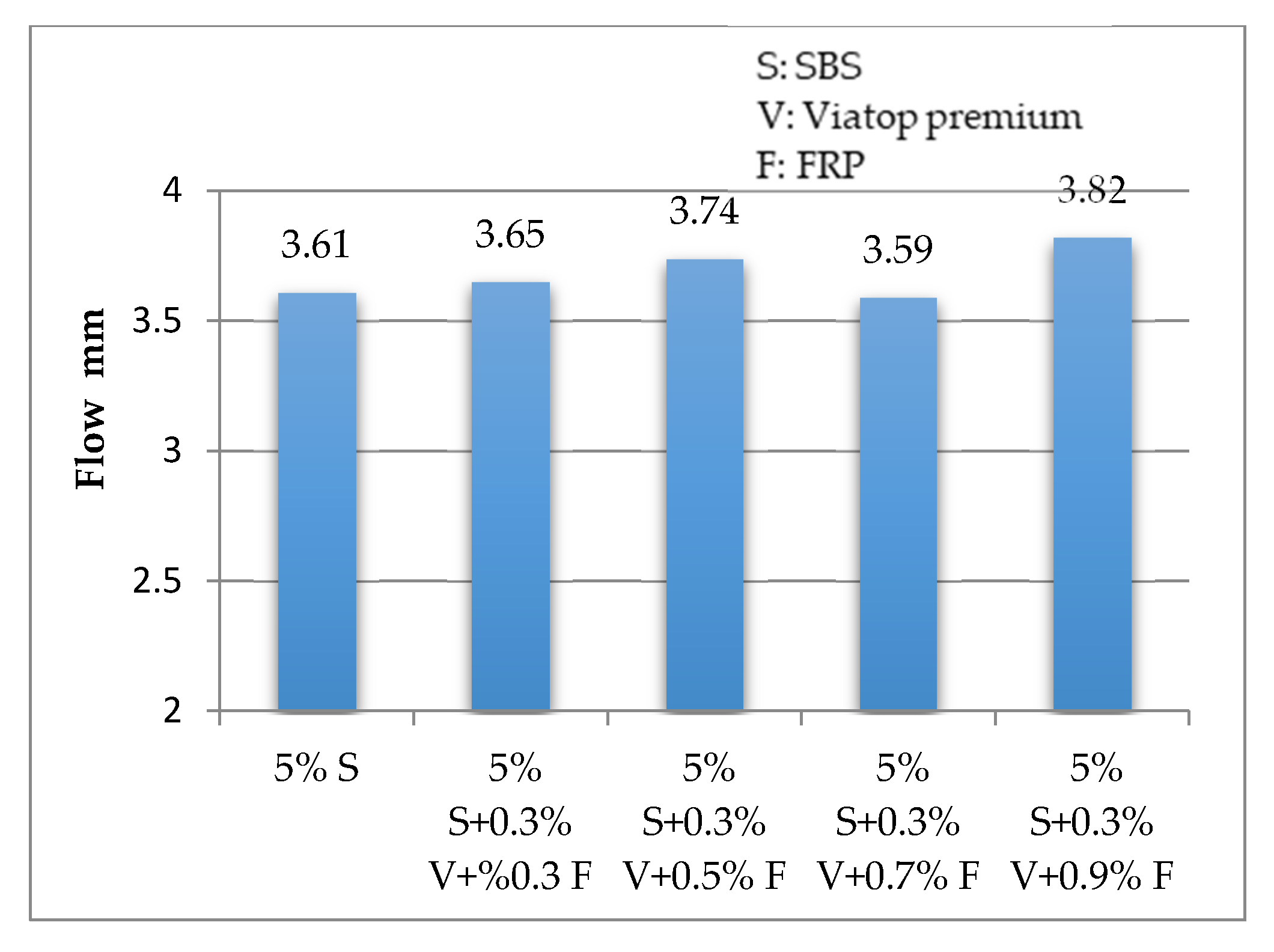

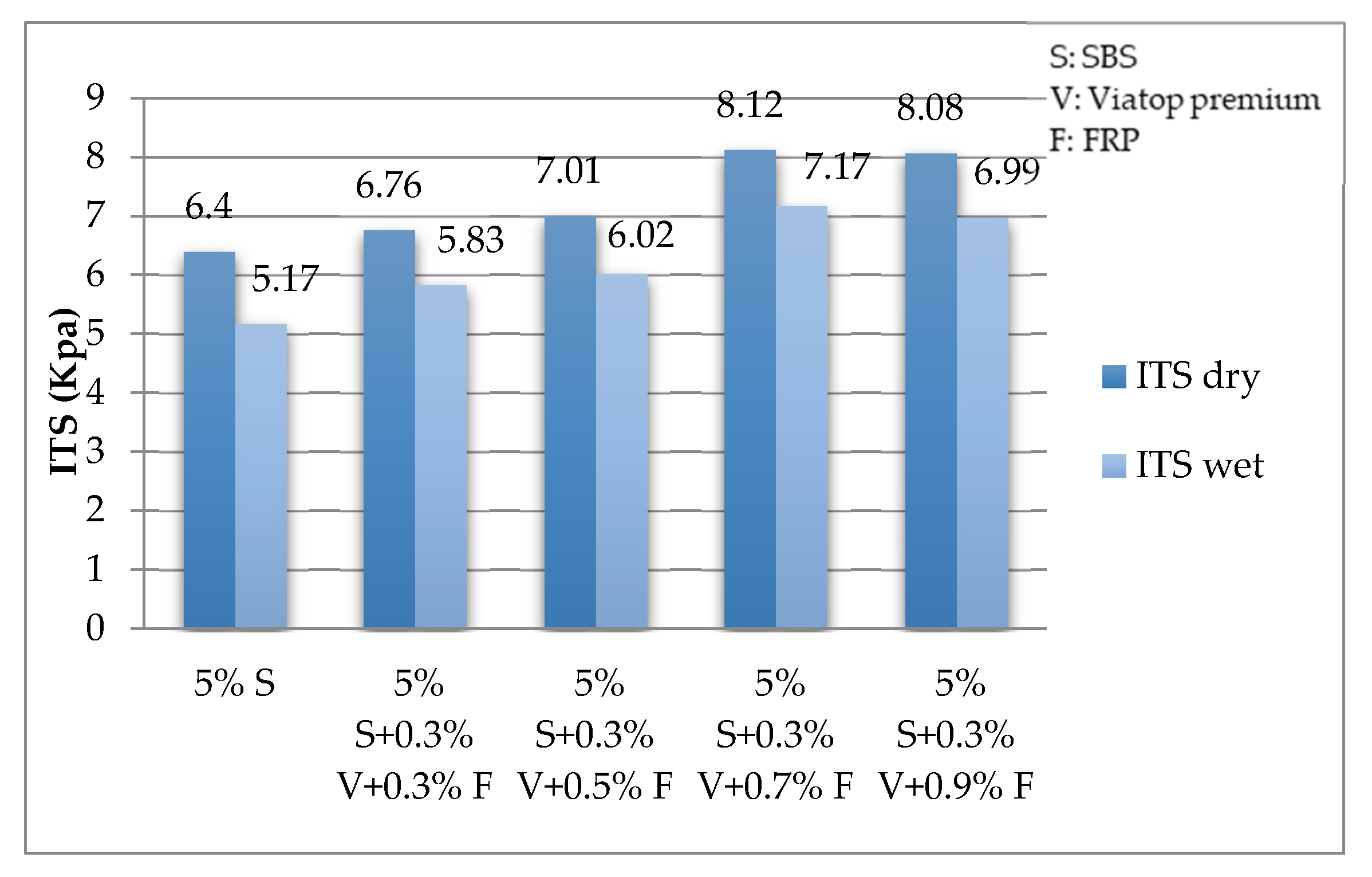
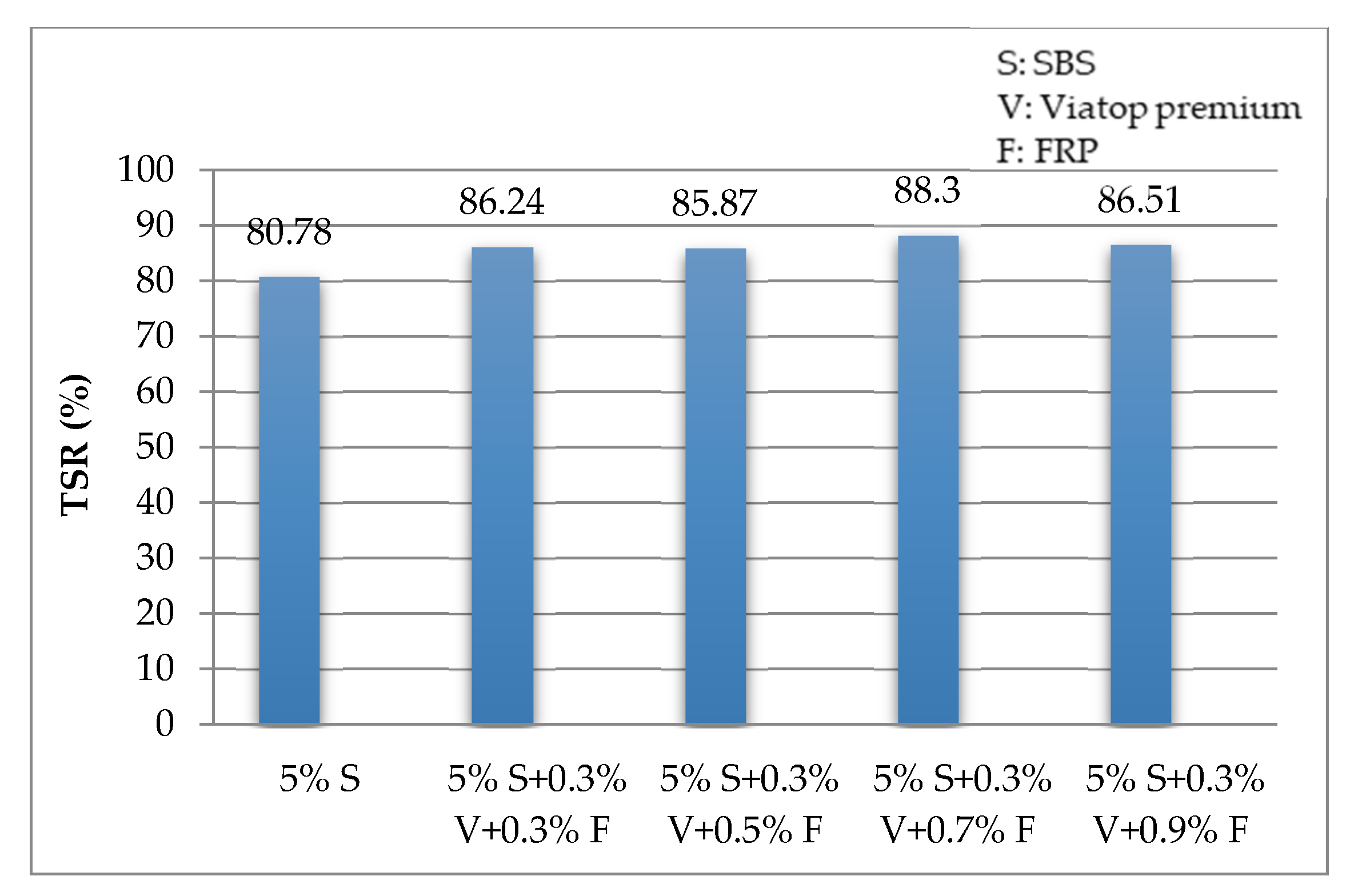
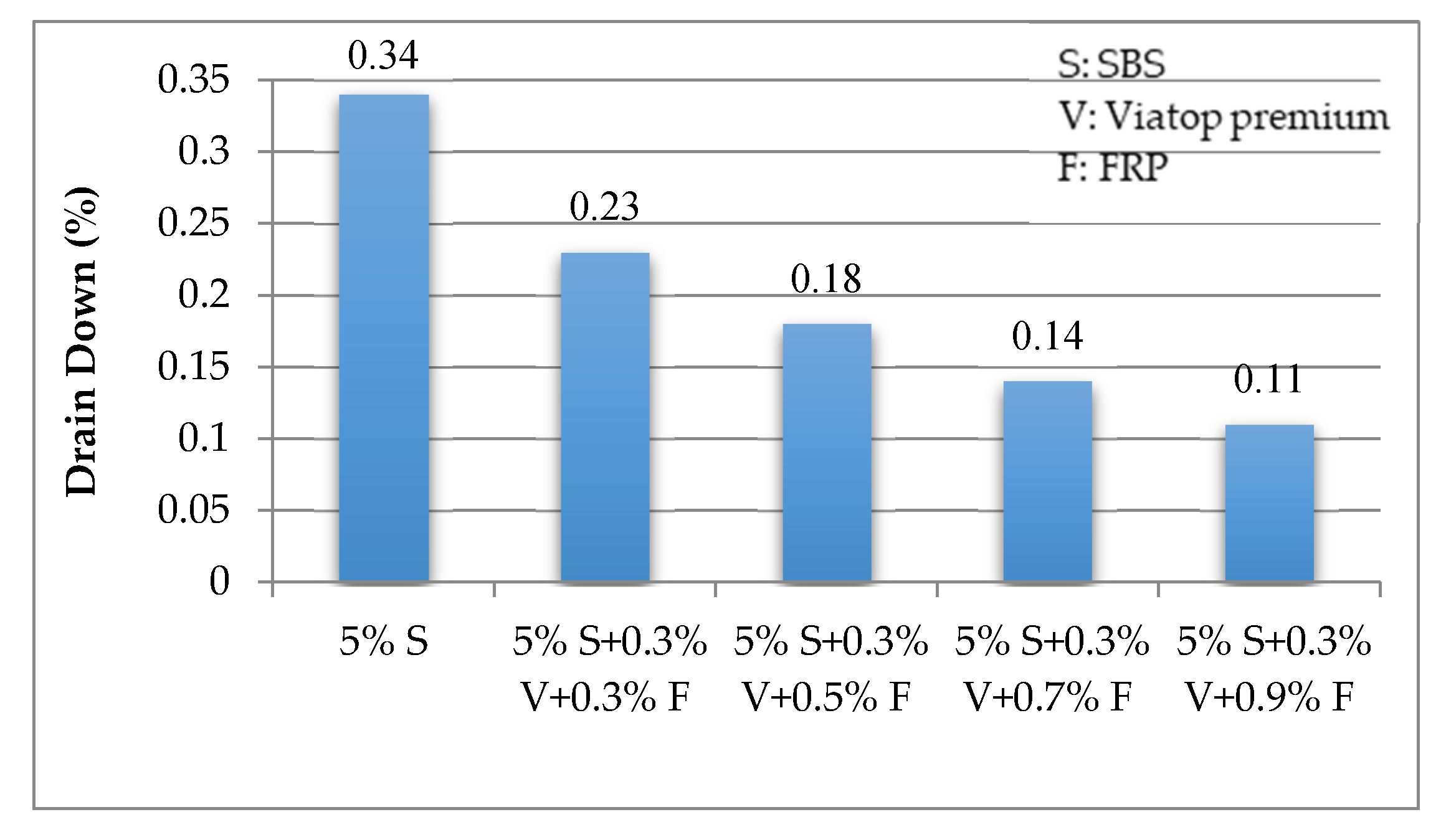
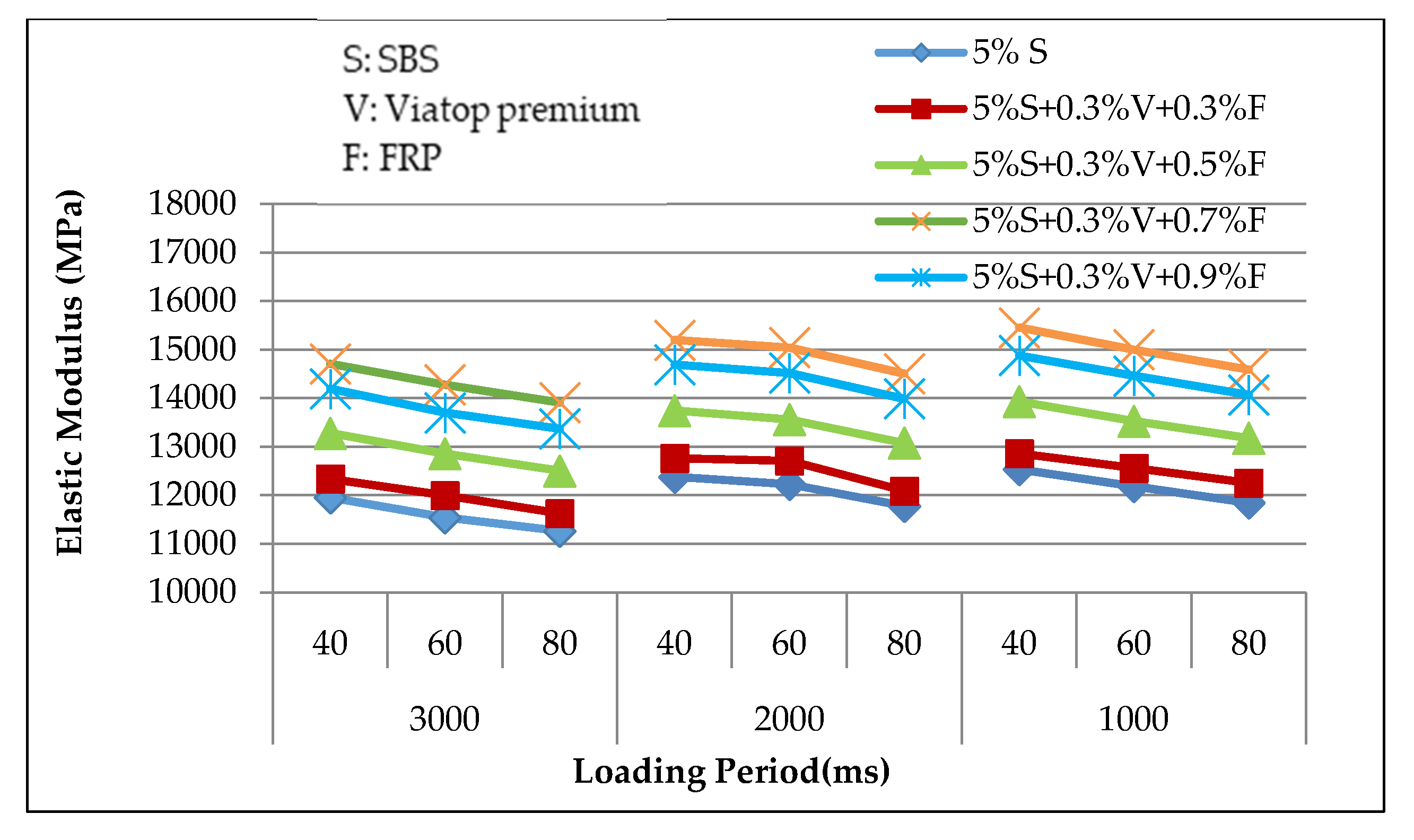
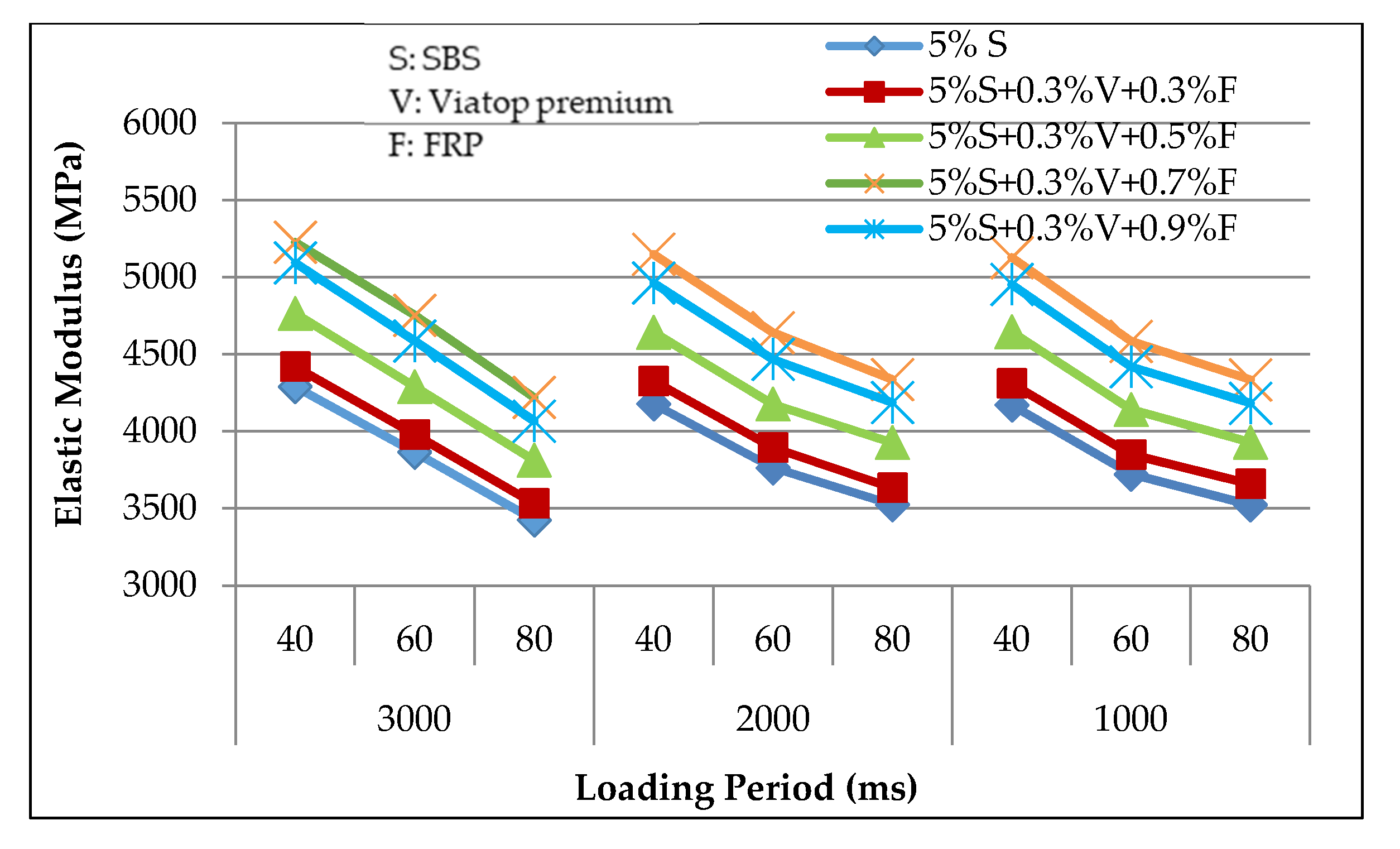
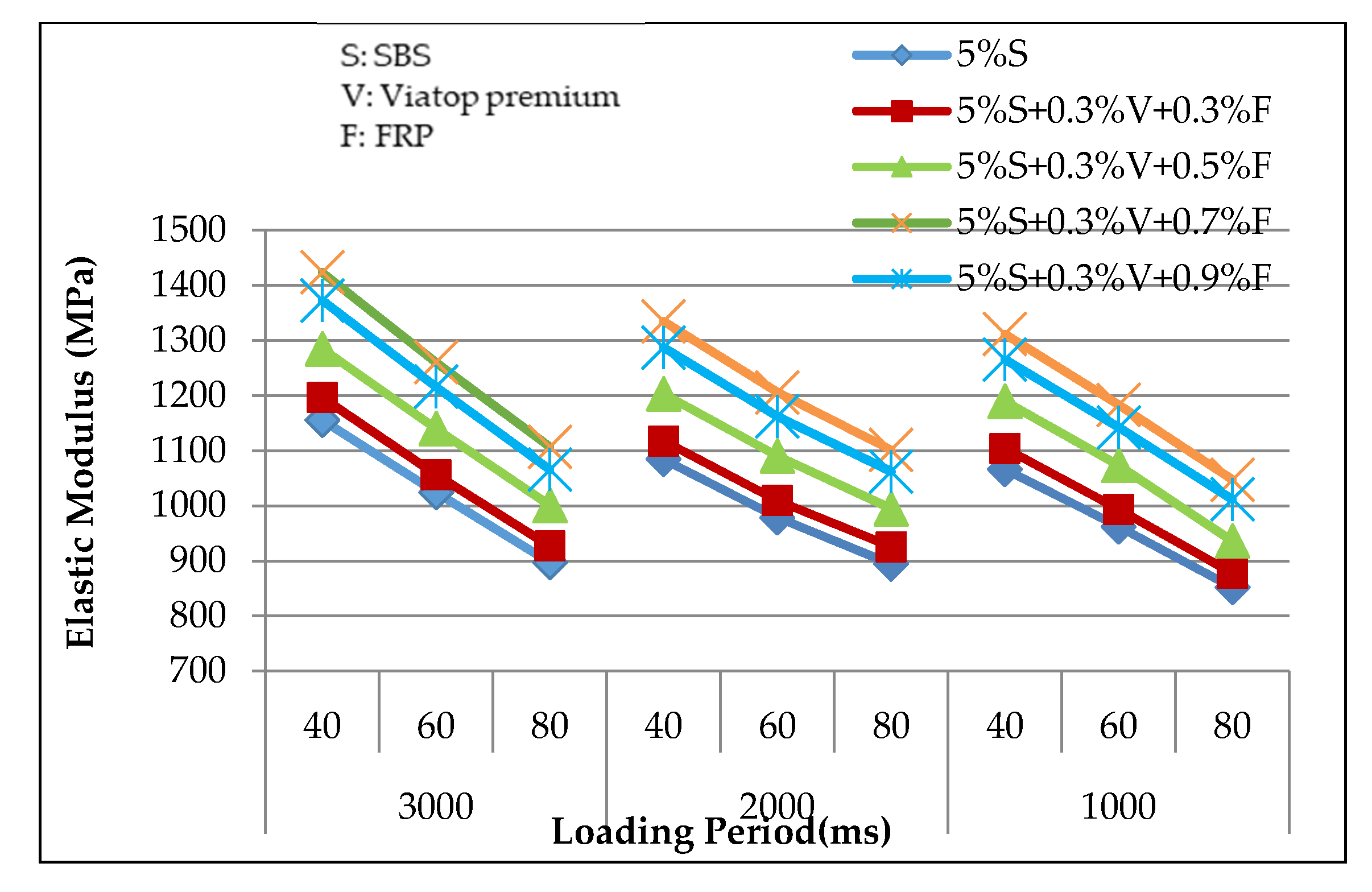

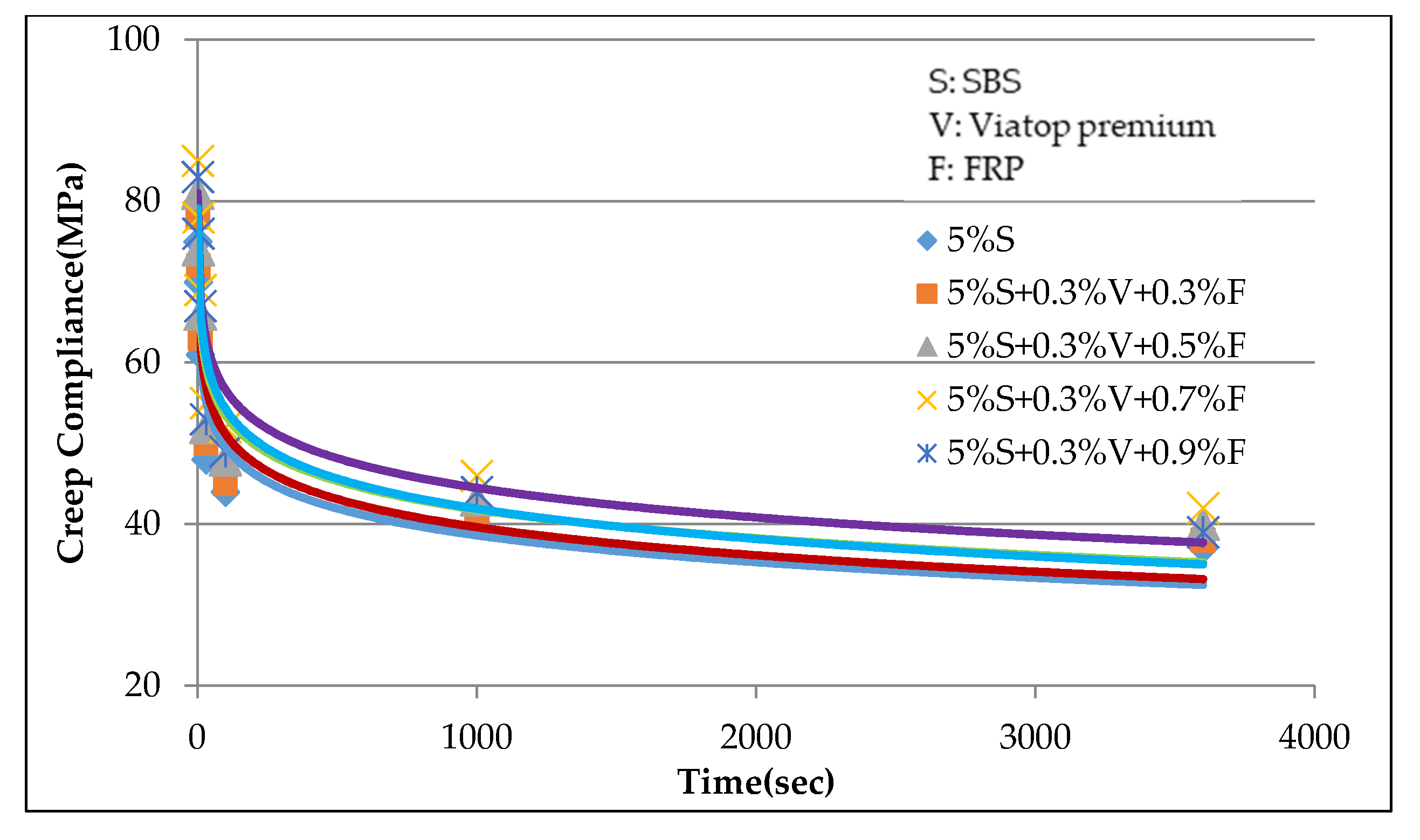
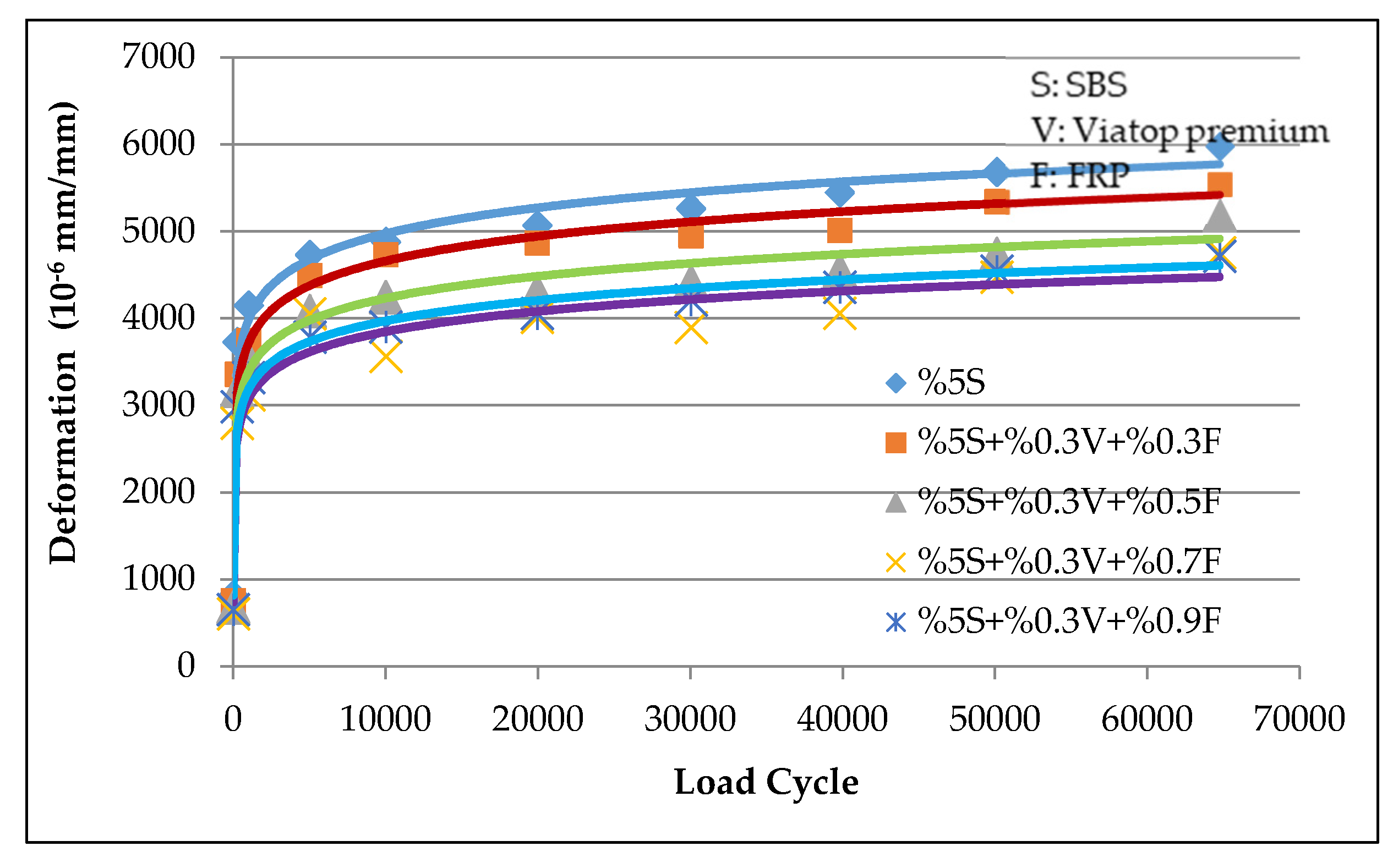
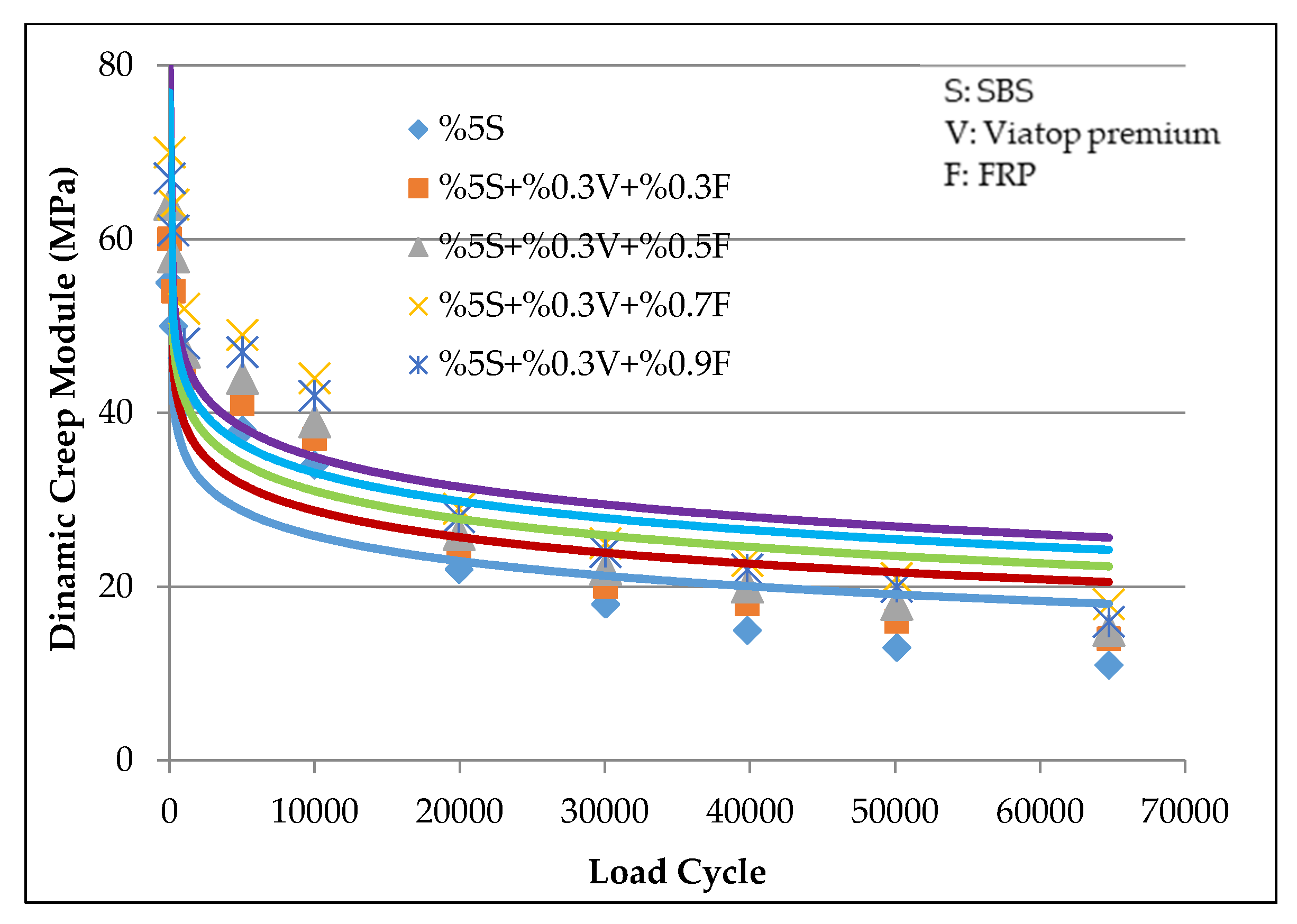
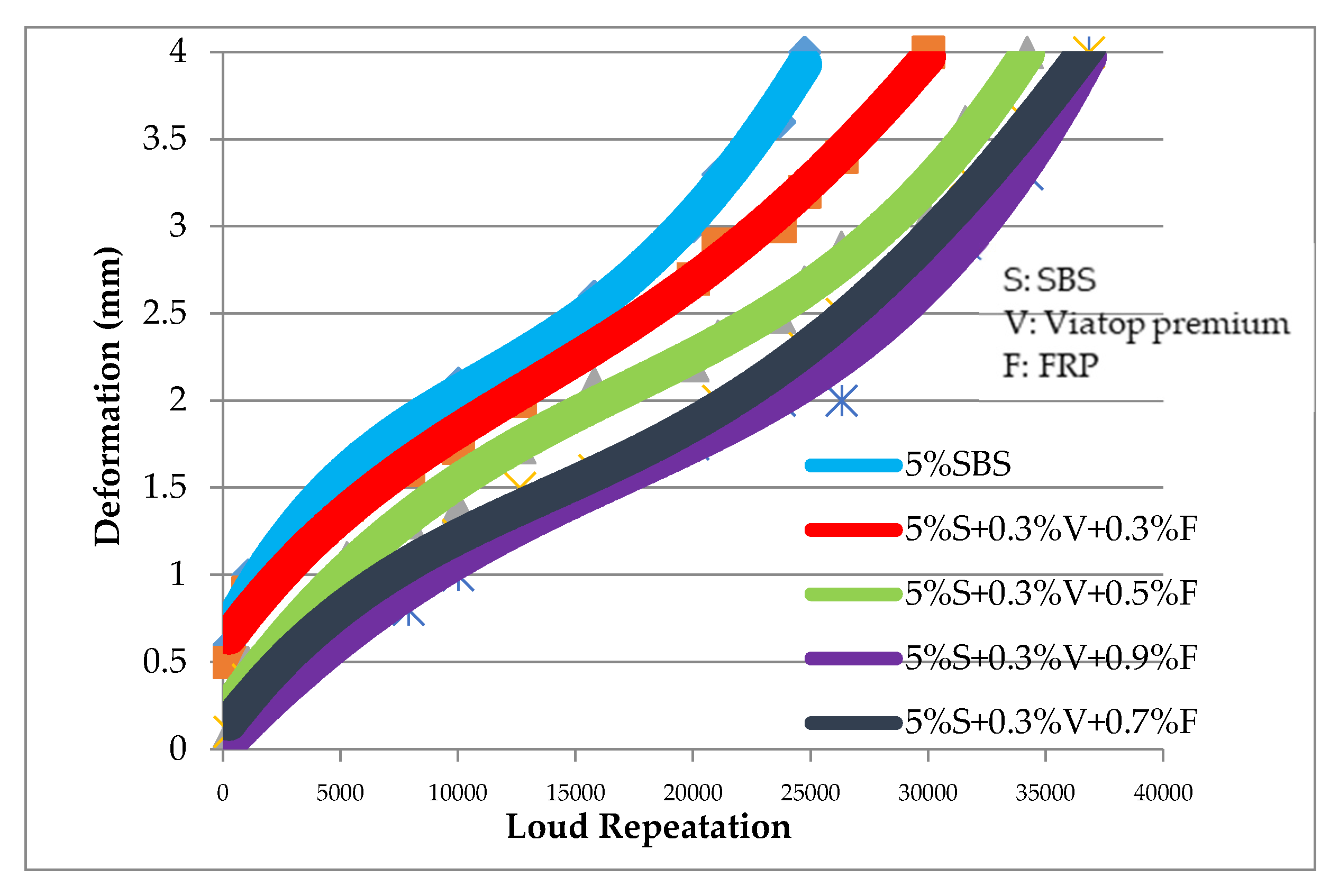
| Properties | Method | Requirement | Values |
|---|---|---|---|
| Coarse aggregate | |||
| Los angeles abrasion (%) | ASTM C131 [19] | 30 max. | 17 |
| Water absorption (%) | ASTM C127 [20] | 5 max. | 0.75 |
| Bulk specific density (g/cm3) | ASTM C127 [20] | - | 2.625 |
| Flat and Elongated (%) | ASTM D4791 [21] | 20 max. | 14 |
| Crushed content (two faces) (%) | ASTM D5821 [22] | 90 min. | 98 |
| Fine aggregate | |||
| Bulk specific density (g/cm3) | ASTM C127 [20] | - | 2.514 |
| Mineral filler | |||
| Bulk specific density (g/cm3) | ASTM C127 [20] | - | 2.757 |
| Parameter Measured | Test Method | Requirement | Test Value |
|---|---|---|---|
| Specific gravity at 25 °C (g/cm3) | ASTM D70 [23] | - | 1.021 |
| Penetration at 25 °C (0.1 mm) | ASTM D5 [24] | - | 63 |
| Softening point (R&B) (°C) | ASTM D36 [25] | - | 50.2 |
| Ductility at 25 °C (cm) | ASTM D113 [26] | Min. 100 | 104 |
| Solubility in Trichloroethylene % | ASTM D-2042 [27] | Min. 99 | 99.4 |
| Flash point (°C) | ASTM D 92 [28] | - | 256 |
| Frass breaking point (°C) | BS EN 12593 [29] | - | −10 |
| Properties | Test Method | Unit | Typical Value | Specification Limits |
|---|---|---|---|---|
| Styrene content | ASTM D1416 [30] | %wt | 31.5 | 30.5–33.5 |
| Hardness | ASTM D2240 [31] | Shore A | 74 | 72–78 |
| Specific weight at 23 °C | ASTM D792 [32] | g/L | 0.93 | 0.92–0.95 |
| Properties | Value |
|---|---|
| Bitumen content (%) | 10, 50/70AC |
| Cellulose content (%) | 90 ARBOSEL ZZ 8.1 |
| fiber length (mm) | 2–6 |
| fiber thickness (mm) | 3 ± 1 |
| Bulk density (g/cm3) | 480–530 |
| Flash point (°C) | 500 |
| Properties | Value |
|---|---|
| Tensile strength MPa | 4137 |
| Density gr/mL3 | 1.81 |
| Fiber Diameter (microns) | 7.2 |
| Carbon content % | 95 |
| SMA Mixture | Stripping (%) |
|---|---|
| 5% SBS | 11 |
| 5% SBS + 0.3% Viatop Premium + 0.3% FRP | 9 |
| 5% SBS + 0.3% Viatop Premium + 0.5% FRP | 9 |
| 5% SBS + 0.3% Viatop Premium +0.7% FRP | 9 |
| 5% SBS + 0.3% Viatop Premium +0.9% FRP | 9 |
© 2020 by the authors. Licensee MDPI, Basel, Switzerland. This article is an open access article distributed under the terms and conditions of the Creative Commons Attribution (CC BY) license (http://creativecommons.org/licenses/by/4.0/).
Share and Cite
Saedi, S.; Oruc, S. The Influence of SBS, Viatop Premium and FRP on the Improvement of Stone Mastic Asphalt Performance. Fibers 2020, 8, 20. https://doi.org/10.3390/fib8040020
Saedi S, Oruc S. The Influence of SBS, Viatop Premium and FRP on the Improvement of Stone Mastic Asphalt Performance. Fibers. 2020; 8(4):20. https://doi.org/10.3390/fib8040020
Chicago/Turabian StyleSaedi, Sepehr, and Seref Oruc. 2020. "The Influence of SBS, Viatop Premium and FRP on the Improvement of Stone Mastic Asphalt Performance" Fibers 8, no. 4: 20. https://doi.org/10.3390/fib8040020
APA StyleSaedi, S., & Oruc, S. (2020). The Influence of SBS, Viatop Premium and FRP on the Improvement of Stone Mastic Asphalt Performance. Fibers, 8(4), 20. https://doi.org/10.3390/fib8040020





